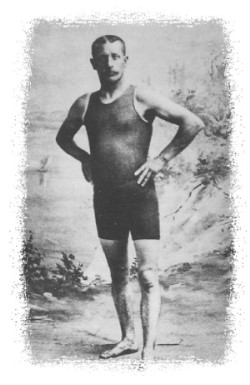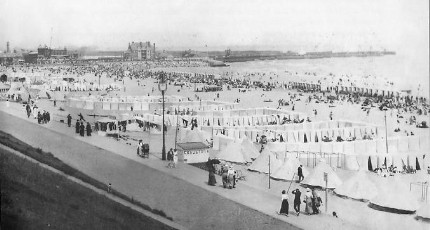Great Yarmouth History
A True Hero from Gorleston-on-Sea
William Adams
Dictionary definition of hero:
"A man distinguished by exceptional courage or one admired for his exploits."

This definition could most definitely be applied to William Adams a son of Gorleston. William's exploits were largely confined to the beach at Gorleston and started when he was the tender age of eleven years. Simply, he saved lives. While William was in the beach area people were safe from drowning. He first came to prominence in 1875 when a young girl fell from the South Pier at Gorleston into the sea. He did not hesitate, he ran to the spot where she had fallen and launched himself into the water and dragged the girl from the jaws of death. His father, Abel Adams, who was a Trinity pilot in Gorleston must have been very proud. Anyone, today, standing on South Pier observing the swirling treacherous waters could be forgiven for thinking twice about jumping in.
Williams first job after leaving school was as a tin plate worker at a local Gorleston firm. He soon tired of this work and he left in favour of becoming a bathing hut attendant on Gorleston beach. This, coupled with becoming a swimming instructor, earned a living for him. During his time he coached some of the best swimmers of the era. He also provided tuition to local schools and clubs.
This was by no means the end of his life saving experiences off Gorleston's beach. In 1896 he saved two men at once. A man had been swept out to sea on an ebb tide. Another went to his rescue but he soon got into difficulties himself. "Professor" Adams, as Wiliam was known to the many people he gave swimming lessons to, swam out to the two men and brought them, together, to the safety of Gorleston's golden sands. On another occasion, he towed a rowing boat with four children on board back to the beach after it had been blown out to sea. William Adams was not tall in stature being only five feet six but he had tremendous strength as the escapade just described illustrates. He was described thus in a local paper; "A fine specimen of English manhood and English pluck - the greatest acquisition of this popular bathing resort.
William Adams died in October 1913 at the age of forty nine giving testament to the saying, "Only the good die young" In August 1913 after being confined to the house for some time owing to ill health William took a walk from his house in Bells Road, Gorleston to his beloved beach. While he was on the beach against all common sense and advice from his doctor he went into the sea to rescue someone. He accomplished the rescue with some help from others on the beach. After this exploit he himself needed help to return home. Within a few months he was dead.
During his life time he received many accolades for his brave exploits in the East Coast waters off Gorleston-on-Sea. He had many awards from the Royal Humane Society, he was recognised by the Carnegie Hero Fund and also received many gifts from the grateful, whom he had rescued. His final resting place is in the cemetry of St Andrews Church, Gorleston and below is the monument on his grave. I believe anyone would be justly proud to attain such an achievement.
It may seem to the modern observer, that the people and visitors to Gorleston, were not very conscious of the dangers of the sea, hence William Adams exploits. However, it must be bourne in mind that the number of people that visited "bathing resorts" as seaside towns were known in the nineteenth century was staggering by todays standards. To give an example, in 1904, the last year the horse drawn tramway operated between Gorleston and Great Yarmouth no less than one million, one hundred ninety three thousand fare paying passengers used the service. Today, I suspect the local bus company would love such numbers aboard its buses, but I doubt they could cope.
Below A typical summer's day in Gorleston ~ early 20th Century
